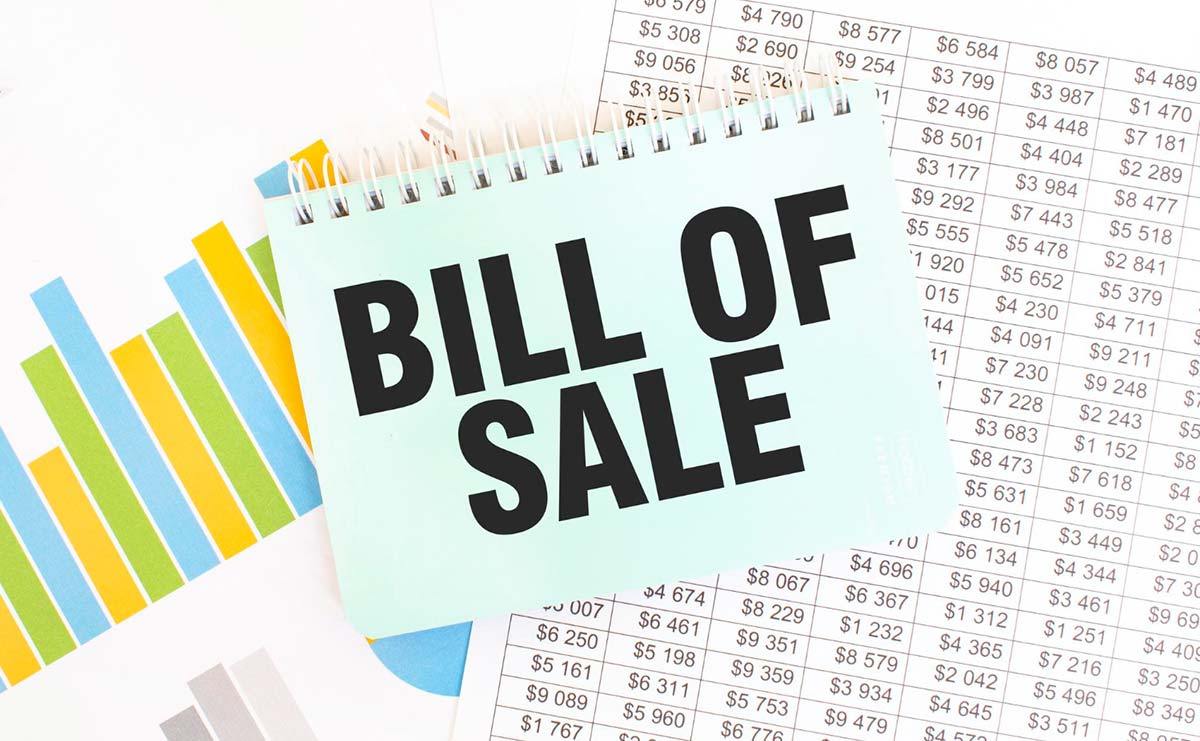Contents
What is a Bill of Sale?
A Bill of Sale is a legal document that serves as proof of the transfer of ownership of an item from a seller to a buyer. It outlines the details of the transaction, including the parties’ identities, a description of the item being sold, the sale price, and the transaction date. Critically, it is a receipt that provides evidence of the sale and the agreed-upon terms.
The Bill of Sale, a document commonly used in vehicles, boats, equipment, or other personal property transactions, offers a shield of protection to both the buyer and the seller. It does so by meticulously documenting the transfer and confirming that the seller has relinquished ownership of the item to the buyer. The document may also include warranties or declarations that the item is free of liens or encumbrances.
While a proper Bill of Sale may be required to register an item with the authorities in some jurisdictions, particularly for vehicles, it is generally a straightforward and simple document. This simplicity should reassure you that ensuring all relevant details are included is crucial for it to be effective in legal settings.
How to Write a Simple Bill of Sale?
When writing a Bill of Sale, the first paragraph is of utmost importance. It sets the stage by stating the transaction date and identifying the parties involved—specifically the seller and the buyer. For clarity, include their full legal names and contact information, as this will be the foundation of the entire document.
Next, provide a detailed description of the item being sold. This includes its make, model, year, serial number, and any relevant distinguishing features or conditions. If it is a vehicle, for example, include the Vehicle Identification Number (VIN) and mileage. This section, crucial for preventing misunderstandings, ensures that both parties agree about what is being transferred.
In the following paragraph, specify the sale price agreed upon by both parties. Clearly state the amount in numerical and written form to avoid any confusion. Also, mention the payment method, whether it’s cash, check, or another form of payment, whether the full payment was made at the time of sale or if any outstanding fees are to be made later.
The next section should include a statement of ownership transfer, where the seller declares that they are the legal owner of the item and have the right to sell it. The seller’s confirmation that the item is free of any liens or encumbrances, unless otherwise stated in the document, is crucial for the buyer’s peace of mind, ensuring they are well-informed and the item is in the expected condition.
Finally, the document should be signed and dated by both the seller and the buyer, with their printed names underneath their signatures. If possible, have the Bill of Sale notarized. This step adds an extra layer of legal protection for both parties, reassuring them and instilling confidence in the transaction’s validity.
How Does a Bill of Sale Work?
A Bill of Sale formalizes the transfer of ownership from one party (the seller) to another (the buyer) for a specific item. Here is how it generally works:
Agreement on Terms: Before creating the Bill of Sale, the seller and buyer must agree on the terms of the sale. This step sets the foundation for the Bill of Sale and ensures both parties are on the same page. The agreement should cover the sale price, the item’s condition, warranties or guarantees, and the payment method.
Drafting the Bill of Sale: The Bill of Sale is then drafted, either by one of the parties or using a template. The document typically includes the following key information:
- Identification of the Parties: The buyer and seller’s full legal names and contact information.
- Description of the Item: A detailed description of the item being sold, including make, model, serial number, and condition.
- Sale Price: The agreed-upon price for the item, stated clearly in both numerical and written form.
- Payment Method: How the payment is being made (cash, check, bank transfer, etc.) and whether it has been made in full or if there are any outstanding payments.
- Transfer of Ownership Statement: A declaration by the seller that they are the rightful owner of the item and have the legal right to sell it. It may also state that the item is free from any liens or encumbrances.
Signing the Bill of Sale: Once the document is complete, both the seller and the buyer sign and date it. This signature indicates that both parties agree to the terms outlined in the Bill of Sale and that the item’s ownership is officially transferred to the buyer.
Transfer of the Item: After the Bill of Sale is signed, the item is handed over to the buyer. At this point, the buyer typically pays the agreed amount to the seller if it hasn’t been done already.
Retention of the Document: It is important that both parties keep a copy of the signed Bill of Sale. The buyer may need it for future reference, such as for registration purposes or to prove ownership. Similarly, the seller should keep it as a transaction record, which can be useful in case of any disputes or for tax purposes.
Legal Protection: The Bill of Sale is a legal protection for both parties. For the buyer, it is proof of ownership and the purchase terms. For the seller, it documents that they no longer own the item and are not responsible for it after the sale.
In some cases, a Bill of Sale may need to be notarized, adding an extra layer of legal verification. This is particularly common in high-value transactions or in jurisdictions where the Bill of Sale is a legal requirement for registering the item with authorities, such as for vehicles or boats. In these instances, the Bill of Sale serves as a crucial document, providing legal proof of the transaction and the transfer of ownership.
What Is the Purpose of Bill of Sale?
The Bill of Sale is important for several reasons, particularly in ensuring the legality and clarity of a transaction involving an item’s ownership transfer. The key reasons are as follows. To create a Bill of Sale, both the buyer and the seller need to agree on the terms of the sale and then document these terms in a legally binding document.
Legal Proof of Ownership: A Bill of Sale is a legal document proving the buyer has acquired ownership of the item from the seller. This is necessary when the buyer needs to register the item, such as a vehicle or boat, with government authorities or for personal records.
Protection for Both Parties: The Bill of Sale is a shield that provides proof that the seller has transferred ownership and is no longer responsible for the item. For the buyer, it is powerful evidence that they have paid for the item and have the right to possess it. This mutual protection is a crucial preparation if any disputes arise after the transaction, ensuring both parties are secure and protected.
Clarity of Transaction Terms: The Bill of Sale is a beacon of clarity that clearly outlines the terms of the sale, including the sale price, the item’s condition, any warranties, and the date of transfer. This clarity ensures that both the buyer and seller are fully informed and clear about what was agreed upon during the sale, preventing any potential misunderstandings or disagreements.
Documentation of Payment: The Bill of Sale often includes details about the payment method and confirmation that the seller has received the agreed-upon amount. Both parties need to ensure that the payment is made as agreed upon.
Evidence in Legal Disputes: If a dispute arises regarding the transaction, such as claims of fraud, misrepresentation, or issues with the item’s condition, the Bill of Sale can be used as evidence in court. For instance, if the buyer claims the item was not as described in the sale, the Bill of Sale can be used to show the agreed-upon condition. This can help resolve the issue more effectively.
Compliance with Legal Requirements: In many jurisdictions, a Bill of Sale is required by law for certain types of transactions, especially for vehicles, boats, or other high-value items. Registering these items and transferring legal ownership with government agencies is required.
Tax Purposes: A Bill of Sale may also be used for tax purposes, mainly when calculating sales tax on the transaction or when the buyer or seller needs to report the sale as part of their financial records.
Peace of Mind: Ultimately, the Bill of Sale is a source of reassurance for both the buyer and the seller. It formalizes the transaction, ensuring that both parties are protected and have clear sale documentation. This reduces the likelihood of future disputes or confusion, instilling a sense of security and confidence in the transaction.
Who Creates a Bill of Sale?
The seller typically writes a bill of sale of the item being transferred. The seller is responsible for detailing the terms of the sale, including the description of the item, the purchase price, the date of the transaction, and any warranties or conditions of the sale. However, both parties (the buyer and the seller) may have input in drafting the document to ensure it accurately reflects their agreement.
In some cases, especially for more complex transactions or in jurisdictions with specific legal requirements, a lawyer or a professional service may draft the bill of sale to ensure it complies with relevant laws and adequately protects the interests of both parties.
Sample of Bill of Sales
BILL OF SALE
Date: [Insert Date]
This Bill of Sale is made on [Date] between [Seller’s Full Name, Address], hereinafter referred to as the “Seller,” and [Buyer’s Full Name, Address], hereinafter referred to as the “Buyer.” The Seller hereby sells to the Buyer the following item: [Detailed Description of the Item, including any unique identifiers].
The total purchase price for the item is [Amount in Words] ([Amount in Numerals]), which has been received by the Seller. The item is sold “as-is” with no warranties or guarantees expressed or implied.
In witness whereof, the undersigned have executed this Bill of Sale on the date first written above.
Seller’s Signature: ____________________
Printed Name: ____________________
Buyer’s Signature: ____________________
Printed Name: ____________________
(Notary Section if applicable): Subscribed and sworn before me this [Date] day of [Month], [Year].
Frequently Asked Questions
Can I write my own bill of sale in Ontario?
Yes, you can write your own bill of sale in Ontario. A bill of sale is a legal document that records the transfer of ownership of an item from a seller to a buyer.
What is a bill of sale Canada?
In Canada, a bill of sale is a legal document that records the transfer of ownership of personal property from one party to another. It is typically used in transactions involving items like vehicles, boats, equipment, or other significant personal assets. The bill of sale provides proof that the transaction occurred and outlines the terms of the sale.
Who keeps bill of sale Ontario?
In Ontario, the bill of sale is primarily kept by the buyer and seller of the item. For certain transactions, such as vehicle sales, you might need to submit a copy of the bill of sale to the Ontario Ministry of Transportation when registering the vehicle in the buyer’s name. It is essential to note that both parties benefit from keeping a copy of the signed document, as it provides a sense of security and protection against potential issues in the future.
Disclaimer: The content provided on this blog is for informational purposes only and does not constitute legal, financial, or professional advice.







